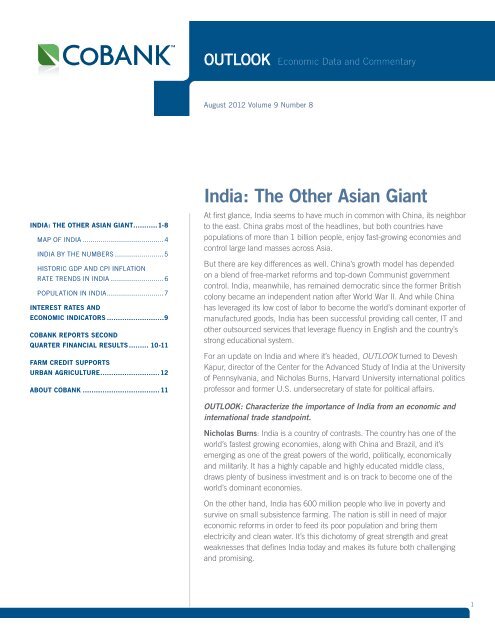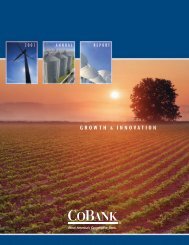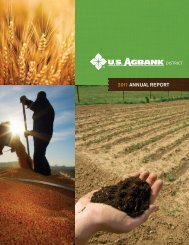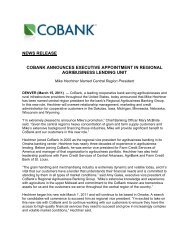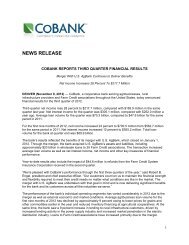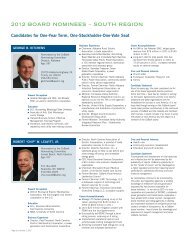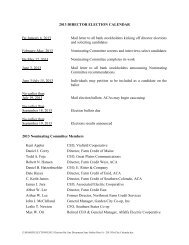India: The Other Asian Giant - CoBank
India: The Other Asian Giant - CoBank
India: The Other Asian Giant - CoBank
Create successful ePaper yourself
Turn your PDF publications into a flip-book with our unique Google optimized e-Paper software.
OUTLOOK Economic Data and Commentary<br />
August 2012 Volume 9 Number 8<br />
INDIA: THE OTHER ASIAN GIANT............1-8<br />
MAP OF INDIA......................................... 4<br />
INDIA BY THE NUMBERS......................... 5<br />
HISTORIC GDP AND CPI INFLATION<br />
RATE TRENDS IN INDIA........................... 6<br />
POPULATION IN INDIA............................. 7<br />
INTEREST RATES AND<br />
ECONOMIC INDICATORS...........................9<br />
COBANK REPORTS SECOND<br />
QUARTER FINANCIAL RESULTS.......... 10-11<br />
FARM CREDIT SUPPORTS<br />
URBAN AGRICULTURE............................12<br />
ABOUT COBANK.................................... 11<br />
<strong>India</strong>: <strong>The</strong> <strong>Other</strong> <strong>Asian</strong> <strong>Giant</strong><br />
At first glance, <strong>India</strong> seems to have much in common with China, its neighbor<br />
to the east. China grabs most of the headlines, but both countries have<br />
populations of more than 1 billion people, enjoy fast-growing economies and<br />
control large land masses across Asia.<br />
But there are key differences as well. China’s growth model has depended<br />
on a blend of free-market reforms and top-down Communist government<br />
control. <strong>India</strong>, meanwhile, has remained democratic since the former British<br />
colony became an independent nation after World War II. And while China<br />
has leveraged its low cost of labor to become the world’s dominant exporter of<br />
manufactured goods, <strong>India</strong> has been successful providing call center, IT and<br />
other outsourced services that leverage fluency in English and the country’s<br />
strong educational system.<br />
For an update on <strong>India</strong> and where it’s headed, OUTLOOK turned to Devesh<br />
Kapur, director of the Center for the Advanced Study of <strong>India</strong> at the University<br />
of Pennsylvania, and Nicholas Burns, Harvard University international politics<br />
professor and former U.S. undersecretary of state for political affairs.<br />
OUTLOOK: Characterize the importance of <strong>India</strong> from an economic and<br />
international trade standpoint.<br />
Nicholas Burns: <strong>India</strong> is a country of contrasts. <strong>The</strong> country has one of the<br />
world’s fastest growing economies, along with China and Brazil, and it’s<br />
emerging as one of the great powers of the world, politically, economically<br />
and militarily. It has a highly capable and highly educated middle class,<br />
draws plenty of business investment and is on track to become one of the<br />
world’s dominant economies.<br />
On the other hand, <strong>India</strong> has 600 million people who live in poverty and<br />
survive on small subsistence farming. <strong>The</strong> nation is still in need of major<br />
economic reforms in order to feed its poor population and bring them<br />
electricity and clean water. It’s this dichotomy of great strength and great<br />
weaknesses that defines <strong>India</strong> today and makes its future both challenging<br />
and promising.<br />
1
OUTLOOK www.cobank.com<br />
In the next decade, one out of four people joining the<br />
global workforce will be <strong>India</strong>n. That’s a phenomenally<br />
young population joining the workforce that can drive<br />
the country’s growth in a significant way.<br />
Devesh Kapur: <strong>India</strong> today is the world’s 10th-largest economy and the<br />
fourth largest in terms of purchasing power. By the end of the decade, <strong>India</strong><br />
is expected to be the fifth-largest economy and the third largest in terms of<br />
purchasing power.<br />
About this article<br />
Nicholas Burns is a professor at<br />
Harvard University and former U.S.<br />
undersecretary of state for political<br />
affairs. At Harvard, he serves as Professor of the<br />
Practice of Diplomacy and International Politics<br />
at the Kennedy School.<br />
Mr. Burns is a member of the Council on Foreign<br />
Relations and served in the U.S. Foreign Service<br />
for 27 years until his retirement in 2008. He<br />
was Under Secretary of State for Political Affairs<br />
from 2005 to 2008 and also served as U.S.<br />
Ambassador to NATO (2001–2005) and to<br />
Greece (1997–2001) and as State Department<br />
Spokesman (1995–1997).<br />
He earned a bachelor’s in history from Boston<br />
College, a master’s in international relations<br />
from the Johns Hopkins School of Advanced<br />
International Studies and earned the Certificat<br />
Pratique de Langue Francaise at the University<br />
of Paris-Sorbonne.<br />
Much of that growth has come from information technology, which grew<br />
from a $10 billion industry in 1990 to $100 billion today. <strong>The</strong> country also<br />
has a rising middle class of more than 200 million people with discretionary<br />
spending who are driving consumer demand for cell phones and cars. <strong>India</strong>’s<br />
favorable demographics also make the country very promising: In the next<br />
decade, one out of four people joining the global workforce will be <strong>India</strong>n.<br />
That’s a phenomenally young population joining the workforce that can drive<br />
the country’s growth in a significant way.<br />
OUTLOOK: How has <strong>India</strong> changed over the past 20 to 30 years?<br />
NB: <strong>India</strong> has seen remarkable change. From its founding in 1947 to the<br />
early 1990s, <strong>India</strong> operated as a semi-closed economy with a heavy dose<br />
of state socialism and restrictions on investment and trade. <strong>The</strong>n, in 1990<br />
and 1991, a series of economic reforms opened up <strong>India</strong> to the international<br />
economy. Those reforms enabled competition, opened up investment and<br />
trade and led to the great expansion of <strong>India</strong>’s economy.<br />
DK: In the past 20 years, the growth rates basically doubled and the<br />
population growth and per capita growth rates tripled. Indicators like literacy,<br />
life expectancy, infant mortality all have seen considerable improvements.<br />
OUTLOOK: What about its population growth?<br />
DK: <strong>India</strong> is likely to surpass China in population in the next few decades. To<br />
give you one way to think about it: In the 20 years between 1991 and 2011,<br />
<strong>India</strong> added 364 million people to its population. That’s more than the total<br />
population of the United States. <strong>The</strong> country has added more people in 20<br />
years than it did in two millennia. That is putting considerable pressures on<br />
natural resources and at the same time driving growth.<br />
2
OUTLOOK www.cobank.com<br />
<strong>The</strong> big question is will <strong>India</strong> succeed in utilizing this labor force, or will it<br />
become a demographic disaster with lots of young people without jobs? For<br />
the rest of the world, <strong>India</strong> could either become a powerhouse like China<br />
or the country will have internal instabilities, which have implications. You<br />
cannot afford to be affected by instability when you’re talking about a fifth of<br />
humanity.<br />
OUTLOOK: How rapidly has the economy been growing in recent years,<br />
and what are the prospects for growth ahead?<br />
About this article<br />
Devesh Kapur is the director<br />
of the Center for the Advanced<br />
Study of <strong>India</strong> at the University of<br />
Pennsylvania. He is also a non-resident fellow at<br />
the Center for Global Development, a think-tank<br />
in Washington, D.C. Before joining the University<br />
of Pennsylvania, he held appointments at the<br />
Brookings Institution, Harvard University and<br />
the University of Texas-Austin.<br />
His most recent book, “Diaspora, Democracy<br />
and Development: <strong>The</strong> Impact of International<br />
Migration from <strong>India</strong>,” received the 2012<br />
Distinguished Book Award of the Ethnicity,<br />
Nationalism, and Migration Section of<br />
International Studies Association.<br />
Dr. Kapur has a master’s in chemical engineering<br />
and a doctorate in public policy from Princeton<br />
University. He received the Joseph R. Levenson<br />
Teaching Prize awarded to the best junior faculty<br />
at Harvard College in 2005.<br />
DK: <strong>India</strong> is among the fastest growing of the G20 countries. <strong>India</strong>’s GDP<br />
growth rate has climbed as high as 10 percent over the past decade. Even<br />
with its economic slowdown projected to drop to 5.5 percent, it’s still growing<br />
faster than most other countries.<br />
Yet if you look at per capita income, <strong>India</strong> is the poorest country of the G20.<br />
<strong>India</strong> would have to continue growing at the pace it has for another 20 years<br />
in order for much of this huge population to reach middle-income status.<br />
OUTLOOK: How well is <strong>India</strong>’s government positioned to manage the<br />
challenges facing the country?<br />
NB: <strong>India</strong> has a stable political system, especially compared to some of its<br />
neighbors. <strong>India</strong> is democratic and has a very vibrant political culture, a<br />
tradition of free and fair elections and a very active parliament. <strong>The</strong>re is every<br />
reason to believe that <strong>India</strong> is going to maintain that political stability.<br />
DK: That’s true, but the one thing about democracies is that they can be<br />
messy, and right now, <strong>India</strong>’s democracy is very messy. That’s partly because<br />
you have a coalition government of multiple parties, so no single party has an<br />
absolute majority. That means different parts of the coalition pull in different<br />
directions and you get policy paralysis – nothing gets done and reforms do<br />
not get passed – and parties extract resources for supporting the government<br />
and you can get very high levels of corruption.<br />
<strong>India</strong> is the only emerging market that has been consistently democratic<br />
since independence 65 years ago. Hence, democracy has deep roots in the<br />
country. But could there be government instability? Quite likely. And when<br />
the main national parties get fewer seats of power, the power starts to flow<br />
to regional parties and to states. That is not necessarily good for national<br />
security or a cohesive foreign policy or for implementing reforms in areas<br />
which are constitutionally the mandate of central government. But it also<br />
strengthens federalism and allows different states to experiment and compete<br />
with each other, which could accelerate reforms in areas where states have<br />
greater leeway.<br />
3
OUTLOOK www.cobank.com<br />
OUTLOOK: What are the key issues facing the <strong>India</strong>n government today?<br />
DK: One thing <strong>India</strong> desperately needs is infrastructure. Over the next<br />
decades it needs transportation systems, such as airports and highways,<br />
urbanization projects like sewage and water, electric power – you name<br />
it. That requires a much more transparent policy environment and better<br />
regulation. <strong>The</strong> nation’s laws for land acquisition – both for new business<br />
development and government projects – have not changed since 1894 and<br />
do not reflect issues of present-day <strong>India</strong>. So acquiring land has become a<br />
huge headache.<br />
<strong>The</strong>re’s also a real concern that the country’s rapid growth has given rise<br />
to serious crony capitalism. Politicians know that with a stroke of a pen,<br />
agricultural land can be designated for industry or commercial purposes<br />
such as urban housing. <strong>The</strong> analogy is that it’s a lot like the late 19th century<br />
United States with powerful robber barons. But unlike the United States that<br />
AFGHANISTAN<br />
JAMMU &<br />
KASHMIR<br />
CHINA<br />
IRAN<br />
HIMACHAL PRADESH<br />
IT<br />
PAKISTAN<br />
RJASTHAN<br />
PUNJAB<br />
HAR-<br />
YANA<br />
UTTAR-<br />
ANCHAL<br />
NEW<br />
DELHI<br />
UTTAR<br />
PRADESH<br />
NEPAL<br />
SIKKIM<br />
BHUTAN<br />
ARUNACHAI<br />
PRADESH<br />
QATAR<br />
BIHAR<br />
ASSAM<br />
NAGALAND<br />
UAE<br />
GUJARAT<br />
MADHYA PRADESH<br />
CHATTISGARH<br />
WEST<br />
BENGAL<br />
BANG-<br />
LADESH<br />
MANIPUR<br />
MIZORAM<br />
OMAN<br />
INDIA<br />
ORISSA<br />
MEGHALAYA<br />
MYANMAR<br />
VIETNAM<br />
MAHARASHTRA<br />
LAOS<br />
ANDHRA<br />
PARADESH<br />
N<br />
KARNATAKA<br />
THAILAND<br />
KERNALA<br />
TIMILNADU<br />
CAMBODIA<br />
200 mi<br />
500 km<br />
SRI<br />
LANKA<br />
4
OUTLOOK www.cobank.com<br />
<strong>India</strong>’s agriculture sector is relatively insulated from the rest<br />
of the world, so rising global food prices do not always have<br />
an immediate impact.<br />
INDIA BY THE NUMBERS<br />
Population........................... 1,205,073,612<br />
Life Expectancy ............................67 years<br />
Median Age...........................26.5 years old<br />
Pop. Below Poverty Line.............. 25 percent<br />
Inflation Rate (2011)................. 6.8 percent<br />
GDP (2011).......................... $4.515 trillion<br />
GDP Growth (2011)....................7.2 percent<br />
GDP by Sector<br />
Agriculture...............................17.2 percent<br />
Industry.................................. 26.4 percent<br />
Services.................................. 56.4 percent<br />
Labor Force............................ 487.6 million<br />
Unemployment (2011)................ 9.8 percent<br />
Exports................................ $298.2 billion<br />
Imports................................... $451 billion<br />
Airports.............................................. 352<br />
Railways.................................... 63,974 km<br />
Roadways..............................3,320,410 km<br />
had some 63 million people in 1890, <strong>India</strong> has 1.2 billion people. Managing<br />
their aspirations in a much more resource-constrained environment is far<br />
more difficult.<br />
OUTLOOK: Is inflation a problem in <strong>India</strong>, as it has been in China and<br />
other high-growth emerging economies?<br />
DK: <strong>India</strong>’s inflation is in the 7 to 8 percent range, which is much higher<br />
than other G20 countries. In a country with so many poor people, that’s<br />
a huge problem because the poor have very few ways to manage price<br />
increases when wages do not increase too. <strong>The</strong> rich obviously are much more<br />
protected.<br />
When you have a coalition government, spending increases and fiscal deficits<br />
climb. That is partly why inflation in <strong>India</strong> has been so high. One way to keep<br />
inflation in check is for the central banks to raise interest rates, but that then<br />
dampens growth.<br />
OUTLOOK: Food prices in <strong>India</strong> have risen even faster than inflation this<br />
year. Why is that?<br />
DK: <strong>India</strong> is facing a drought, which has had an impact of rising food prices.<br />
Back in the 1960s, the country once was a major food importer but it has<br />
since been able to boost crop yields and improve its agriculture production.<br />
<strong>India</strong>’s agriculture sector is relatively insulated from the rest of the world, so<br />
rising global food prices do not always have an immediate impact within <strong>India</strong>.<br />
Merchant Marine Fleet............... 240 vessels<br />
Number of cellphones............... 752 million*<br />
*Second highest number in the world<br />
behind China<br />
Source: CIA World Factbook<br />
5
OUTLOOK www.cobank.com<br />
OUTLOOK: Does <strong>India</strong> hold significant promise as an export market for<br />
American agriculture?<br />
DK: <strong>India</strong>n agriculture is currently protected by relatively high tariffs, mainly<br />
because agriculture employs about 600 million to 700 million people. But as<br />
pressures on land in <strong>India</strong> grow, it will become more open to U.S. agricultural<br />
imports.<br />
OUTLOOK: Has <strong>India</strong> grown into a more market-oriented economy over<br />
the past 20 years?<br />
DK: If you believe the corruption stories, then everything is up for sale in<br />
<strong>India</strong>, including parts of government. That’s a bit facetious but it’s indicative<br />
of perceptions. <strong>India</strong> has moved to become a much more market economy,<br />
but it still has parts of the economy where the government controls prices<br />
and exercises discretionary powers. <strong>The</strong> government still controls the prices<br />
for energy – petroleum, diesel, kerosene as well as electric power. This<br />
has increased fiscal deficits and reduced investment in this sector. Much<br />
of <strong>India</strong>’s recent huge blackout can be blamed on excessive government<br />
controls and not allowing markets to work. No one is going to spend billions<br />
of dollars on setting up power plants, transmission lines and distribution<br />
systems if they know that prices might be regulated in ways that are not<br />
transparent.<br />
HISTORIC GDP AND CPI INFLATION RATE TRENDS IN INDIA<br />
12%<br />
10%<br />
10.9 9.5<br />
8%<br />
9.3 9.4 9.6<br />
8.4<br />
9.2<br />
7.2<br />
6%<br />
4%<br />
4.2<br />
5.8<br />
6.4<br />
5.1<br />
7.7<br />
6.8<br />
2%<br />
0%<br />
2005<br />
GDP Growth<br />
2006 2007 2008 2009 2010 2011<br />
Inflation<br />
Sources: World Bank. CMIE. global-rates.com<br />
6<br />
1,600,000,000
OUTLOOK www.cobank.com<br />
OUTLOOK: What are the exports of <strong>India</strong>?<br />
12%<br />
10%<br />
8%<br />
6%<br />
4%<br />
2%<br />
0%<br />
9.3 9.4 9.6<br />
4.2<br />
2005<br />
GDP Growth<br />
5.8<br />
6.4<br />
DK: <strong>The</strong> top exports include software and outsourced IT services,<br />
transportation equipment, machinery, pharmaceuticals and refined<br />
petroleum products. <strong>India</strong> has a strong generic drug sector, which has mixed<br />
effects on a country like the United States. On one hand, generics are much<br />
less expensive so American pharmaceutical companies face considerable<br />
cost pressures, 10.9 but it’s great 9.5 for the U.S. consumers looking to cut health<br />
care costs.<br />
9.2<br />
8.4<br />
7.2<br />
OUTLOOK: How does the bad global economy affect <strong>India</strong>n exports?<br />
7.7<br />
DK: Last quarter <strong>India</strong>’s exports registered 6.8 a slight decline of 1.5 percent.<br />
While it may not seem much of a drop, they had been growing very strongly<br />
5.1<br />
in double digits so it’s large relative to trend forecasts. It’s an effect of low<br />
growth in global demand.<br />
OUTLOOK: <strong>India</strong>’s growth forecasts were recently revised downward to<br />
5.5. percent. Why?<br />
2006 2007 2008 2009 2010 2011<br />
DK: That is clearly driven by the governance issues. When you have policy<br />
Inflation<br />
paralysis and the perception of widespread corruption in government then<br />
businesses begin to lose confidence. That’s important but not the only<br />
reason. <strong>The</strong> world economy has also gone down in general.<br />
POPULATION IN INDIA<br />
1,600,000,000<br />
1,400,000,000<br />
1,200,000,000<br />
1,000,000,000<br />
800,000,000<br />
600,000,000<br />
400,000,000<br />
200,000,000<br />
0<br />
1950 1960 1970 1980 1990 2000 2010 2020 2030 2040 2050<br />
<strong>India</strong> Population (U.S. Census Bureau, International Data Base)<br />
Source: www.360.org<br />
7
OUTLOOK www.cobank.com<br />
When you have a country as large as <strong>India</strong> and it grows rapidly<br />
it has linkages to the rest of the world. You get more innovation,<br />
more demand for goods and services as well as the supply of<br />
goods and services at cheaper rates.<br />
OUTLOOK: How does what is going on in <strong>India</strong> impact the U.S. economy?<br />
DK: <strong>India</strong>n IT has reduced the cost for American businesses. If they<br />
outsource to <strong>India</strong>, it lowers the overall costs of their business. Back in 1990,<br />
the <strong>India</strong>n IT market was too small to be bothered with – but not today. If you<br />
look at the Indo-U.S. Chamber of Commerce it has the crème de la crème of<br />
American companies.<br />
NB: Trade and investment is at an all-time high between the United States<br />
and <strong>India</strong>. One of the bridges between the two countries has been the<br />
high-tech sector. We see more <strong>India</strong>n-U.S. joint ventures and more <strong>India</strong>n-<br />
Americans succeeding in the United States. <strong>The</strong>re has been a wholesale<br />
transformation in the way the United States and <strong>India</strong> work together over the<br />
last 20 years.<br />
OUTLOOK: What does a strong <strong>India</strong> mean to the rest of the world?<br />
DK: Emerging markets doing well economically through democratic means is<br />
congruous with U.S. values. When you have a country as large as <strong>India</strong> and it<br />
grows rapidly it has linkages to the rest of the world. You get more innovation,<br />
more demand for goods and services as well as the supply of goods and<br />
services at cheaper rates.<br />
OUTLOOK: How will <strong>India</strong>’s long-term growth impact energy markets?<br />
NB: As an industrial power, <strong>India</strong> is becoming a major importer of oil and<br />
gas from sources around the world. Together with China, their energy needs<br />
are having a significant impact on global energy markets. <strong>India</strong> and the U.S.<br />
reached a landmark Civil Nuclear agreement during the Bush administration<br />
which should, once implemented, help <strong>India</strong> to increase its share of peaceful<br />
civil nuclear power with the help of U.S. firms.<br />
8
OUTLOOK www.cobank.com<br />
OUTLOOK: What should the posture of the United States be toward <strong>India</strong><br />
from a foreign policy standpoint?<br />
NB: <strong>India</strong> and the U.S. have become close friends and partners during the<br />
last decade. Presidents Clinton, Bush and Obama have all worked to bring<br />
our two countries closer together. On Afghanistan, for example, <strong>India</strong> has<br />
given significant assistance to the Karzai government. Our two militaries also<br />
train and exercise together in the <strong>India</strong>n Ocean. <strong>The</strong> U.S. also hopes to see<br />
conflict avoided between <strong>India</strong> and Pakistan, two nuclear weapons powers.<br />
<strong>India</strong> is fast becoming one of our most valuable friends in the Asia-Pacific<br />
theater – now the most important region in the world for U.S. strategic<br />
interests.<br />
OUTLOOK: Where do you see <strong>India</strong> 20 years from today? Are you<br />
optimistic or pessimistic?<br />
NB: I am optimistic about <strong>India</strong>. Think of its advantages. It is the world’s<br />
largest democracy, has a very strong high tech sector and enormous<br />
mathematics and engineering talent in its population. Like the United States,<br />
it is also a multi-ethnic and multi-religious country that prizes its diversity. I<br />
see <strong>India</strong> as one of the future global success stories. Sure, it faces serious<br />
challenges and problems in its development but there is enormous room for<br />
further progress and growth.<br />
9
Interest Rates and<br />
Economic Indicators<br />
<strong>The</strong> interest rate and economic data on this page were updated as<br />
of 07/31/12. <strong>The</strong>y are intended to provide rate or cost indications<br />
only and are for notional amounts in excess of $5 million except for<br />
forward fixed rates.<br />
KEY ECONOMIC INDICATORS<br />
Gross Domestic Product (GDP) measures the change in total output of the<br />
U.S. economy. <strong>The</strong> Consumer Price Index (CPI) is a measure of consumer<br />
inflation. <strong>The</strong> federal funds rate is the rate charged by banks to one another<br />
on overnight funds. <strong>The</strong> target federal funds rate is set by the Federal Reserve<br />
as one of the tools of monetary policy. <strong>The</strong> interest rate on the 10-year U.S.<br />
Treasury Note is considered a reflection of the market’s view of longer-term<br />
macroeconomic performance; the 2-year projection provides a view of more<br />
near-term economic performance.<br />
ECONOMIC AND INTEREST RATE PROJECTIONS<br />
Source: Insight Economics, LLC and Blue Chip Economic Indicators<br />
US Treasury Securities<br />
2012 GDP CPI Funds 2-year 10-year<br />
Q3 2.10% 1.40% 0.15% 0.30% 1.60%<br />
Q4 2.30% 1.80% 0.15% 0.30% 1.80%<br />
2013 GDP CPI Funds 2-year 10-year<br />
Q1 1.90% 2.10% 0.15% 0.40% 1.90%<br />
OUTLOOK www.cobank.com<br />
HEDGING THE COST OF FUTURE LOANS<br />
A forward fixed rate is a fixed loan rate on a specified balance that can<br />
be drawn on or before a predetermined future date. <strong>The</strong> table below lists<br />
the additional cost incurred today to fix a loan at a future date.<br />
FORWARD FIXED RATES<br />
Cost of Forward Funds<br />
Forward<br />
Period<br />
(Days)<br />
Average Life of Loan<br />
2-yr 3-yr 5-yr 10-yr<br />
30 5 5 5 5<br />
90 5 8 10 11<br />
180 5 10 17 19<br />
365 5 23 34 36<br />
Costs are stated in basis points per year.<br />
SHORT-TERM INTEREST RATES<br />
This graph depicts the recent history of the cost to fund floating rate loans.<br />
Three-month LIBOR is the most commonly used index for short-term financing.<br />
3-MONTH LIBOR<br />
Q2 2.40% 2.00% 0.15% 0.50% 2.10%<br />
Q3 2.70% 2.30% 0.20% 0.60% 2.20%<br />
YIELD<br />
6.00%<br />
5.00%<br />
Q4 2.90% 2.20% 0.20% 0.60% 2.30%<br />
4.00%<br />
3.00%<br />
PROJECTIONS OF FUTURE INTEREST RATES<br />
<strong>The</strong> table below reflects current market expectations about interest rates<br />
at given points in the future. Implied forward rates are the most commonly<br />
used measure of the outlook for interest rates. <strong>The</strong> forward rates listed are<br />
derived from the current interest rate curve using a mathematical formula<br />
to project future interest rate levels.<br />
2.00%<br />
1.00%<br />
0.00%<br />
1/1/06<br />
5/1/06<br />
Daily Rate<br />
30 Day Moving Avg.<br />
8/29/06<br />
12/27/06<br />
4/26/07<br />
8/24/07<br />
12/22/07<br />
4/20/08<br />
8/18/08<br />
12/16/08<br />
4/15/09<br />
8/13/09<br />
12/11/09<br />
4/10/10<br />
8/8/10<br />
12/6/10<br />
4/5/11<br />
8/3/11<br />
12/1/11<br />
3/30/12<br />
7/28/12<br />
IMPLIED FORWARD SWAP RATES<br />
Years<br />
Forward<br />
3-month<br />
LIBOR<br />
1-year<br />
Swap<br />
3-year<br />
Swap<br />
5-year<br />
Swap<br />
7-year<br />
Swap<br />
10-year<br />
Swap<br />
Today 0.45% 0.40% 0.49% 0.81% 1.20% 1.63%<br />
0.25 0.28% 0.36% 0.52% 0.88% 1.27% 1.69%<br />
0.50 0.37% 0.40% 0.58% 0.96% 1.35% 1.76%<br />
0.75 0.39% 0.42% 0.64% 1.05% 1.43% 1.82%<br />
1.00 0.41% 0.45% 0.71% 1.13% 1.51% 1.89%<br />
RELATION OF INTEREST RATE TO MATURITY<br />
<strong>The</strong> yield curve is the relation between the cost of borrowing and the time<br />
to maturity of debt for a given borrower in a given currency. Typically,<br />
interest rates on long-term securities are higher than rates on short-term<br />
securities. Long-term securities generally require a risk premium for<br />
inflation uncertainty, for liquidity, and for potential default risk.<br />
TREASURY YIELD CURVE<br />
1.50 0.44% 0.50% 0.89% 1.33% 1.67% 2.02%<br />
2.00 0.52% 0.62% 1.09% 1.52% 1.81% 2.16%<br />
2.50 0.71% 0.85% 1.32% 1.71% 1.99% 2.28%<br />
3.00 0.90% 1.09% 1.56% 1.90% 2.17% 2.41%<br />
4.00 1.44% 1.56% 1.99% 2.25% 2.45% 2.61%<br />
YIELD<br />
3.50%<br />
3.00%<br />
2.50%<br />
2.00%<br />
1.50%<br />
5.00 1.91% 2.04% 2.33% 2.53% 2.67% 2.78%<br />
1.00%<br />
0.50%<br />
July 2012<br />
3 Months Ago<br />
6 Months Ago<br />
0.00%<br />
3m 6m 1 2 3 5 10 15 30<br />
10
OUTLOOK www.cobank.com<br />
<strong>CoBank</strong> Reports Second<br />
Quarter Financial Results<br />
<strong>CoBank</strong> recently announced financial results for the second quarter of 2012.<br />
Second quarter net income rose almost 40 percent to $252.4 million,<br />
compared with $180.7 million for the second quarter of last year. Net<br />
interest income for the quarter was $307.1 million, compared with $276.5<br />
million a year ago. Average loan volume for the quarter was $69.4 billion,<br />
compared to $52.1 billion for the same period in 2011.<br />
About <strong>CoBank</strong><br />
<strong>CoBank</strong> is a $90 billion cooperative bank<br />
serving vital industries across rural America.<br />
<strong>The</strong> bank provides loans, leases, export<br />
financing and other financial services to<br />
agribusinesses and rural power, water and<br />
communications providers in all 50 states.<br />
<strong>The</strong> bank also provides wholesale loans and<br />
other financial services to affiliated Farm Credit<br />
associations serving more than 70,000 farmers,<br />
ranchers and other rural borrowers in 23 states<br />
around the country.<br />
<strong>CoBank</strong> is a member of the Farm Credit<br />
System, a nationwide network of banks and<br />
retail lending associations chartered to support<br />
the borrowing needs of U.S. agriculture and the<br />
nation’s rural economy. Headquartered outside<br />
Denver, Colorado, <strong>CoBank</strong> serves customers<br />
from regional banking centers across the<br />
U.S. and also maintains an international<br />
representative office in Singapore.<br />
For more information about <strong>CoBank</strong>, visit the<br />
bank’s web site at www.cobank.com<br />
Commentary in Outlook is for general information only and<br />
does not necessarily reflect the opinion of <strong>CoBank</strong>. <strong>The</strong><br />
information was obtained from sources that <strong>CoBank</strong> believes<br />
to be reliable but is not intended to provide specific advice.<br />
For the first six months of 2012, net income increased 23 percent to $482.9<br />
million from $392.8 million for the same period in 2011. Net interest income<br />
increased 7 percent to $620.2 million. Total loan volume for the bank at<br />
June 30, 2012 was $69.2 billion.<br />
<strong>The</strong> bank’s results reflected the benefits of its merger with U.S. AgBank,<br />
which closed on January 1, 2012. Through the merger, the bank acquired<br />
U.S. AgBank’s assets and liabilities, including approximately $20 billion in<br />
wholesale loans to 25 Farm Credit associations. <strong>The</strong> transaction increased<br />
average loan volume as well as net interest income, net income and certain<br />
other key measures of financial performance.<br />
Second-quarter and year-to-date results also included the impact of $44.6<br />
million in refunds from the Farm Credit System Insurance Corporation.<br />
“We’re pleased with <strong>CoBank</strong>’s results through the midpoint of 2012,” said<br />
Robert B. Engel, president and chief executive officer. “<strong>The</strong> merger with U.S.<br />
AgBank continues to deliver significant benefits for our business at a time<br />
of real challenge in the broader market environment. We remain focused<br />
on building the financial strength and flexibility of the bank and meeting the<br />
needs of our customers across all of the industries we serve.”<br />
<strong>The</strong> performance of the bank’s individual operating segments has varied<br />
in 2012 due to the merger as well as external economic and market<br />
factors. Average agribusiness loan volume declined significantly owing to<br />
lower average prices for grains and other commodities earlier in the year<br />
and reduced inventory financing at agricultural cooperatives. At the same<br />
time, the bank continues to experience solid growth in lending to rural<br />
infrastructure customers, particularly in the power supply and electric<br />
distribution industries. Loans to Farm Credit associations have increased<br />
significantly due to the merger, but organic growth in that segment is soft<br />
due to continuing low demand for debt capital at the producer level of the<br />
U.S. farm economy.<br />
At quarter end, 1.02 percent of the bank’s loans were classified as adverse<br />
assets, the same level as at the end of the first quarter and down from 1.25<br />
percent at December 31, 2011. Nonaccrual loans improved to $106.9<br />
11
OUTLOOK www.cobank.com<br />
million, compared to $125.0 million in the prior quarter and $134.9 million<br />
at the end of the year. During the second quarter, the bank recorded a $5.0<br />
million provision for loan losses, increasing the provision to $10.0 million for<br />
the first half of the year. <strong>The</strong> provision for loan losses in the first six months<br />
of 2011 was $37.5 million.<br />
“Credit quality in <strong>CoBank</strong>’s loan portfolio remains strong compared to<br />
historical averages,” said David P. Burlage, <strong>CoBank</strong>’s chief financial officer.<br />
“<strong>CoBank</strong> continues to benefit from the addition of U.S. AgBank’s portfolio<br />
of high quality loans to Farm Credit associations, as well as relatively strong<br />
conditions in the U.S. rural economy.”<br />
<strong>The</strong> bank’s allowance for credit losses totaled $547.7 million at June 30,<br />
2012, or 1.77 percent of non-guaranteed loans outstanding excluding loans<br />
to Farm Credit associations.<br />
Capital and liquidity levels at <strong>CoBank</strong> remain well above regulatory<br />
minimums. As of June 30, 2012, shareholders’ equity totaled $6.2 billion,<br />
and the bank’s permanent capital ratio was 15.8 percent, compared with<br />
the 7.0 percent minimum established by the Farm Credit Administration,<br />
the bank’s independent regulator. At quarter end, <strong>CoBank</strong>’s cash and<br />
investments totaled $19.7 billion and days liquidity totaled 193 days. During<br />
the quarter, the bank recorded $3.0 million in impairment losses on certain<br />
investment securities, compared with $4.0 million in impairment losses<br />
during the same quarter last year.<br />
Engel noted that overall conditions in the U.S. and global economies remain<br />
weak, putting downward pressure on loan demand in many of the industries<br />
served by the bank. Many areas in the United States are also currently<br />
being impacted by drought conditions, which has the potential to reduce<br />
revenues at grain and farm supply cooperatives and increase costs in the<br />
protein and biofuels sectors. In addition, extremely low interest rates and a<br />
flattened yield curve make it more difficult to generate meaningful earnings<br />
on invested capital.<br />
“Despite these challenges, we believe <strong>CoBank</strong> remains well positioned<br />
to continue fulfilling its mission to agriculture, rural infrastructure, and<br />
rural America,” Engel said. “Under the guidance of our board, we remain<br />
committed to providing our customers with exceptional, sustainable value<br />
and to managing the enterprise for the long term.”<br />
12
OUTLOOK www.cobank.com<br />
<strong>CoBank</strong> Supports Urban<br />
Agriculture<br />
<strong>CoBank</strong> has joined forces with two other Farm Credit institutions to provide<br />
financial support for beginning urban farmers in Cleveland as part of the<br />
city’s “Gardening for Greenbacks” program.<br />
Minneapolis-based AgriBank, Denver-based <strong>CoBank</strong> and Louisville-based<br />
Farm Credit Mid-America each committed $45,000 to the program for a<br />
total donation of $135,000. All three institutions are members of the Farm<br />
Credit System, a nationwide network of banks and associations chartered to<br />
meet the credit needs of agriculture and other key rural industries.<br />
Gardening for Greenbacks is an initiative developed by the city of Cleveland<br />
to increase the production of local foods and establish Cleveland as a model<br />
for local food system development. By providing financial assistance to local<br />
entrepreneurs for the development of for-profit urban food gardens, the<br />
program aims to encourage economic development while helping to ensure<br />
that every resident has access to fresh, healthy and affordable food.<br />
“As a mission-based lender, we are committed to encouraging the<br />
development of local food systems, including urban farming,” said Andrew<br />
Jacob, executive vice president at <strong>CoBank</strong>. We’re delighted to be partnering<br />
with other Farm Credit organizations in support of this innovative program.”<br />
<strong>The</strong> Farm Credit donation will fund grants of up to $5,000 to enable program<br />
participants acquire the necessary equipment for urban gardening, such<br />
as tools, fencing and irrigation systems. Grant recipients are required to<br />
successfully complete a market gardener training class offered by the Ohio<br />
State University Extension and to sell their produce locally.<br />
13


